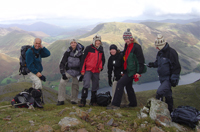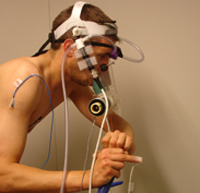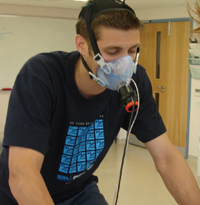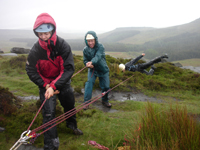Teaching on ice: an educational expedition to Antarctica Inspire article
Are there days when you long to get right away from the classroom? How far would you be willing to go? Eleanor Hayes talks to Phil Avery, one of four teachers who are taking a break from school to journey to the Antarctic.

District: left to right: Ian, Phil,
Zoe (reserve), Ruth, Amy,
Richard (reserve guide)
Image courtesy of Steve Bull
(expedition leader)
On 3 November 2007, four teachers from the UK will head to the Ellsworth Mountains of Antarctica to camp for four weeks. The aim of the expedition is to inspire geography and science students with live reports from the ice and to conduct research projects, the results of which will be turned into exciting and innovative teaching resources.
The expedition is organised by the Fuchs Foundationw1, founded in honour of Sir Vivian Fuchs, the Antarctic scientist who completed the first-ever crossing of the continent in 1957/58. The Foundation’s aim is to inspire teachers to change students’ lives, challenging the idea that science and geography are dull, and awakening a sense of excitement, adventure and the thirst for knowledge. By targeting teachers, they hope to reach millions of students, working on the principle that each teacher will influence 10 000 students over the course of their career.
Research on ice
All four of the teachers have their own projects, which they will then convert into exciting lessons for their students within the framework of the national curriculum. For example, Phil Avery, a geography teacher at Oxted School in the UK, is working with the University of Portsmouth, UK, to discover how humans cope physiologically and psychologically with extreme cold. Before and after the expedition, the four teachers and two guides will undergo fitness tests, anthropometric profiling (which examines body shape) and psychological questionnaires.
Amongst other activities, they will be cycling inside a walk-in freezer (-20ºC) wearing swimming costumes! The point is to see at what core body temperature they start to sweat and then, once they have stopped cycling, shiver. The results will be compared before and after the expedition to see if they are due to the harsh conditions experienced (temperatures in Antarctica will be around -30ºC plus wind chill).
The selected teachers are neither research scientists nor explorers and have never done anything like this before. And they have only just met in training. All this adds a whole new, ‘Big Brother’-style dimension. How will they cope with the stress? Will they argue? Will they (or the ice) crack up? This is one of the reasons that the University of Portsmouth were so keen to test them mentally as well as physically.
Training

(he’s not swearing, he’s got a
thermistor on his finger!)
Image courtesy of Phil Avery

oxygen uptake test (he has
excellent endurance and lactic
acid threshold)
Image courtesy of Phil Avery
The teachers have already completed two training trips in northern England, focusing on how to camp in a cold environment and how to move on ice. All went well, except for when they left their stoves behind…if they repeat this mistake in Antarctica, they will die! Fortunately, training ensures that the teachers can learn from their mistakes before the real expedition begins.
And of course, there are other types of training course, explains Phil. “I spent one weekend contemplating bones poking through legs, guts on the outside, scratched retinas, rotten toes, dislocated elbows, lacerations, collapsed lungs, swelling brains, heart attacks, spinal injuries and diarrhoea. This wasn’t TV – I was on a medical course for people who are going to be more than 24 hours from professional help. The list of injuries sustained while on expeditions made me wonder if this expedition was a sensible idea!”
To check that they are ready for the rigours of the expedition, the teachers are currently undergoing tests to see how well adapted they are to the cold. Exactly how much fat do they have and where is it? How quickly do they start sweating and how much sweat do they produce? How fit are they? What happens if they are submersed in cold water? How well do their hands work in the cold? “It could be quite demoralising,” worries Phil. “What if they say ‘you are scrawny, unfit and incapable of operating in the cold…enjoy the Antarctic!’?”
As we go to press, the crucial training trip is still to come: in August 2007, they will head for a week to Norway to camp on a glacier, complete crevasse rescue drills and learn to cross-country ski while pulling sledges loaded with equipment.
Applications at school
When the teachers return from Antarctica, they will use their experiences and the results of their experiments to produce valuable resources for schools, available on the Fuchs Foundation websitew1. The advantage of sending teachers on an expedition instead of the more usual research scientists is that they have the experience and opportunity to really bring the Antarctic to life in the classroom.

Zoe as they practise using a
pulley system to rescue team
members from crevasses
Image courtesy of Phil Avery
The subject of the Antarctic lends itself not only to biology lessons on physiology, geography lessons about climate, or physics lessons about state change, but also to a wide variety of interdisciplinary topics. For example, Antarctic tourism could be discussed within the English geography syllabus, travel and tourism syllabus or citizenship syllabus (see Phil’s blogw2 for more details); and the history of Antarctica spans geography, history and food technology (explorers’ diets).
Although the expedition hasn’t yet begun, Phil is already using it to excite his students. In a recent school assembly, he held 2200 secondary-school students spellbound with his description of a vast continent on the other side of the planet, the extreme conditions, and the expedition itself: its educational aims, the idea of untrained teachers pulling a sledge across the snowy expanses and the very real danger involved.
“With so much administration in education,” he muses, “have we forgotten that possibly the best teaching tool is great stories – and giving teachers time to research them and tell them well?”
Phil is also keen to get younger children thinking about the Antarctic and what we can learn from such a harsh environment. With some help from teachers who contacted him via his websitew2, he is planning several workshops with local primary schools.
- Penguin huddling. One of the ways penguins respond to the harsh conditions of Antarctica is by grouping together. “After showing the children lots of great pictures of Antarctic wildlife, I am going to take the children outside, huddle them together and get them to measure temperatures on the outside and inside of the group to see the difference that body heat makes.”
- Kit lists. By considering what equipment they would take on an expedition to Antarctica, the children will start thinking about the conditions they would face. “To get them started, I will bring along some mountaineering equipment, and talk about old kit and modern kit. We can also have a scenario in which we get too tired and weak to pull the heavily loaded sledges; the children should then consider which pieces of kit are most essential.”
Phil had to consider many of these points himself recently, when buying kit for the expedition.
“Do I really need this item, or will it just be extra weight to carry around? What sort of spoon shall I buy? A metal one would freeze to my lips, but a plastic spoon will become brittle – I’d better get a wooden one. Is my knife sharp enough to cut ropes easily and free me from my sledge if I fall down a crevasse? Is my first-aid kit able to support an injured person who might not be rescued for days?”
Other teachers are also keen to hear about the expedition and its results. In particular, they are interested in how it could be included in climate-change projects, science careers evenings and a consideration of extreme environments. If you have further ideas, why not check Phil’s blogw2 and leave comments.
When they return
When the teachers return at the end of the year, they will be busy producing teaching materials to share their experiences with colleagues around the world. But we hope they will have time to talk to Science in School so that we can let you know how the expedition went.
Funding
Half of the expedition costs are covered by the Fuchs Foundation but each participating teacher must raise £10 000 with the support of their schools, friends and others. Additional donors and sponsors are very welcome!
Phil explains one of the positive side-effects of fund-raising: “I now know a lot about the romantic nature of my school, after I ran a service with which members of the school could send flowers to each other. Year 8 [ages 13-14] are the most romantic year (about half of the students sent flowers) and teachers are the least romantic (obviously not all that staff-room gossip is true!). Year-8 students are also the ‘most desirable’ year (receiving the most flowers) with teachers being the ‘least desirable’.”
Competition
Here is your chance to get answers to questions you have about Antarctica, the effects of cold on humans or other related topics. Send us your ideas for simple experiments to be performed during the expedition; Phil and his companions will choose and carry out the best one. They will send back the results live from Antarctica, for publication on the Science in School website.
Entries are welcome from science teachers across Europe and should reach us (editor@scienceinschool.org) by 30 September 2007. Please include your school, country and the subjects you teach.
To get you thinking, here’s one of the questions sent in so far: Does your saliva freeze before it hits the ground?
Web References
- w1 – The Fuchs Foundation website, including blogs.
- w2 – Phil Avery’s website, including a blog, photos and an online donation form.
- w3 – Phil Avery’s blog plus videos, podcasts and other materials on the website of Teaching Expertise, one of the expedition’s sponsors.
Resources
- To watch and download a (free) video of the expedition, see: http://www.teachers.tv/video. Other videos about the preparation for the expedition, the experiments carried out and the issues raised are also available on the Teachers TV
Review
Many European countries are suffering from a lack of scientific vocations which might soon become a fundamental problem. A common explanation is that the effort to become a scientist is not rewarded with social or economic success. However, the best reward in science is always the sense of adventure that any research involves.
Phil Avery’s project brings into the classroom the importance of effort and risk that is involved in any research, and is a good tool to motivate students to explore the world of scientific research.
As a possible application of the article, teachers could encourage their students to design a research project for an expedition to a national or European region. The students could use this article as a guide to design the training and equipment necessary, and how to use their results.
Juan de Dios Centeno Carrillo, Spain





